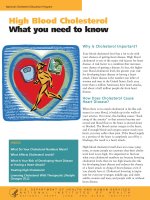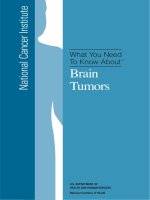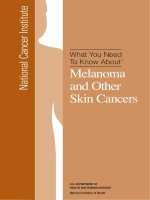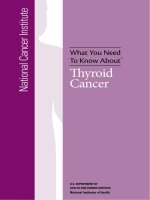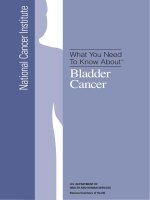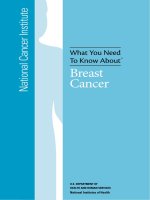Tài liệu High Blood Cholesterol What you need to know ppt
Bạn đang xem bản rút gọn của tài liệu. Xem và tải ngay bản đầy đủ của tài liệu tại đây (195.59 KB, 6 trang )
National Cholesterol Education Program
WWhhyy IIss CChhoolleesstteerrooll IImmppoorrttaanntt??
Your blood cholesterol level has a lot to do with
your chances of getting heart disease. High blood
cholesterol is one of the major risk factors for heart
disease. A risk factor is a condition that increases
your chance of getting a disease. In fact, the higher
your blood cholesterol level, the greater your risk
for developing heart disease or having a heart
attack. Heart disease is the number one killer of
women and men in the United States. Each year,
more than a million Americans have heart attacks,
and about a half million people die from heart
disease.
HHooww DDooeess CChhoolleesstteerrooll CCaauussee
HHeeaarrtt DDiisseeaassee??
When there is too much cholesterol (a fat-like sub-
stance) in your blood, it builds up in the walls of
your arteries. Over time, this buildup causes “hard-
ening of the arteries” so that arteries become nar-
rowed and blood flow to the heart is slowed down
or blocked. The blood carries oxygen to the heart,
and if enough blood and oxygen cannot reach your
heart, you may suffer chest pain. If the blood supply
to a portion of the heart is completely cut off by a
blockage, the result is a heart attack.
High blood cholesterol itself does not cause symp-
toms, so many people are unaware that their choles-
terol level is too high. It is important to find out
what your cholesterol numbers are because lowering
cholesterol levels that are too high lessens the risk
for developing heart disease and reduces the chance
of a heart attack or dying of heart disease, even if
you already have it. Cholesterol lowering is impor-
tant for everyone–younger, middle age, and older
adults; women and men; and people with or without
heart disease.
High Blood Cholesterol
What you need to know
IINNSSIIDDEE::
What Do Your Cholesterol Numbers Mean?
What Affects Cholesterol Levels?
What Is Your Risk of Developing Heart Disease
or Having a Heart Attack?
Treating High Cholesterol
Lowering Cholesterol With Therapeutic Lifestyle
Changes (TLC)
WWhhaatt DDoo YYoouurr CChhoolleesstteerrooll NNuummbbeerrss MMeeaann??
Everyone age 20 and older should have their cholesterol measured at least once every 5 years. It is best to have
a blood test called a “lipoprotein profile” to find out your cholesterol numbers. This blood test is done after a
9- to 12-hour fast and gives information about your:
■ Total cholesterol
■ LDL (bad) cholesterol – the main source of cholesterol buildup and blockage in the arteries
■ HDL (good) cholesterol – helps keep cholesterol from building up in the arteries
■ Triglycerides – another form of fat in your blood
If it is not possible to get a lipoprotein profile done, knowing your total cholesterol and HDL cholesterol
can give you a general idea about your cholesterol levels. If your total cholesterol is 200 mg/dL*
or more or if your HDL is less than 40 mg/dL, you will need to have a lipoprotein profile done.
See how your cholesterol numbers compare to the tables below.
*Cholesterol levels are measured in milligrams (mg) of cholesterol per deciliter (dL) of blood.
HDL (good) cholesterol protects against heart disease, so for HDL, higher numbers are better.
A level less than 40 mg/dL is low and is considered a major risk factor because it increases your risk
for developing heart disease. HDL levels of 60 mg/dL or more help to lower your risk for heart disease.
Triglycerides can also raise heart disease risk. Levels that are borderline high (150-199 mg/dL)
or high (200 mg/dL or more) may need treatment in some people.
WWhhaatt AAffffeeccttss CChhoolleesstteerrooll LLeevveellss??
A variety of things can affect cholesterol levels. These are things you can do something about:
■ Diet. Saturated fat and cholesterol in the food you eat make your blood cholesterol level go up.
Saturated fat is the main culprit, but cholesterol in foods also matters. Reducing the amount of
saturated fat and cholesterol in your diet helps lower your blood cholesterol level.
■ Weight. Being overweight is a risk factor for heart disease. It also tends to increase your cholesterol.
Losing weight can help lower your LDL and total cholesterol levels, as well as raise your
HDL and lower your triglyceride levels.
■ Physical Activity. Not being physically active is a risk factor for heart disease. Regular
physical activity can help lower LDL (bad) cholesterol and raise HDL (good) cholesterol
levels. It also helps you lose weight. You should try to be physically active for 30 minutes
on most, if not all, days.
Things you cannot do anything about also can affect cholesterol levels. These include:
■ Age and Gender. As women and men get older, their cholesterol levels rise. Before the age
of menopause, women have lower total cholesterol levels than men of the same age. After the age
of menopause, women’s LDL levels tend to rise.
■ Heredity. Your genes partly determine how much cholesterol your body makes. High blood
cholesterol can run in families.
Total Cholesterol Level Category
Less than 200 mg/dL Desirable
200-239 mg/dL Borderline high
240 mg/dL and above High
LDL Cholesterol Level LDL Cholesterol Category
Less than 100 mg/dL Optimal
100-129 mg/dL Near optimal/above optimal
130-159 mg/dL Borderline high
160-189 mg/dL High
190 mg/dL and above Very high
My risk category is ________.
If You Have You Are in Category
Heart disease, diabetes, or risk score more than 20%* I. High Risk
2 or more risk factors and risk score 10-20% II. Next Highest Risk
2 or more risk factors and risk score less than 10% III. Moderate Risk
0 or 1 risk factor IV. Low-to-Moderate Risk
1
SStteepp 11
2
SStteepp 22
3
SStteepp 33
❍ Cigarette smoking
❍ High blood pressure (140/90 mmHg or higher or on blood pressure medication)
❍ Low HDL cholesterol (less than 40 mg/dL)*
❍ Family history of early heart disease (heart disease in father or brother before
age 55; heart disease in mother or sister before age 65)
❍ Age (men 45 years or older; women 55 years or older)
*If your HDL cholesterol is 60 mg/dL or higher, subtract 1 from your total count.
Even though obesity and physical inactivity are not counted in this list, they are conditions that
need to be corrected.
Check the table below to see how many of the listed risk factors you have;
these are the risk factors that affect your LDL goal.
Major Risk Factors That Affect Your LDL Goal
WWhhaatt IIss YYoouurr RRiisskk ooff DDeevveellooppiinngg HHeeaarrtt DDiisseeaassee oorr
HHaavviinngg aa HHeeaarrtt AAttttaacckk??
In general, the higher your LDL level and the more risk factors you have (other than LDL), the
greater your chances of developing heart disease or having a heart attack. Some people are at high
risk for a heart attack because they already have heart disease. Other people are at high risk for
developing heart disease because they have diabetes (which is a strong risk factor) or a combination
of risk factors for heart disease. Follow these steps to find out your risk for developing heart disease.
Use your medical history, number of risk factors, and risk score to find your
risk of developing heart disease or having a heart attack in the table below.
My 10-year risk score is ________%.
How many major risk factors do you have? If you have 2 or more risk
factors in the table above, use the risk scoring tables on the back
page (which include your cholesterol levels) to find your risk score.
Risk score refers to the chance of having a heart attack in the next
10 years, given as a percentage.
(Use the Framingham Point Scores on the back page.)
*Means that more than 20 of 100 people in this category will have a heart attck
within 10 years.
TTrreeaattiinngg HHiigghh CChhoolleesstteerrooll
The main goal of cholesterol-lowering treatment is to lower your LDL level enough to reduce your risk
of developing heart disease or having a heart attack. The higher your risk, the lower your LDL goal will
be. To find your LDL goal, see the box for your risk category below. There are two main ways to lower
your cholesterol:
Category I, High Risk, your LDL goal is less than 100 mg/dL. You will need to begin the TLC diet to
reduce your high risk even if your LDL is below 100 mg/dL. If your LDL is 100 mg/dL or above, you will
need to start drug treatment at the same time as the TLC diet. If your LDL is below 100 mg/dL, you may
also need to start drug treatment together with the TLC diet if your doctor finds your risk is very high,
for example if you have had a recent heart attack or have both heart disease and diabetes.
Category II, Next Highest Risk, your LDL goal is less than 130 mg/dL. If your LDL is 130 mg/dL or
above, you will need to begin treatment with the TLC diet. If your LDL is 130 mg/dL or more after
3 months on the TLC diet, you may need drug treatment along with the TLC diet. If your LDL is less
than 130 mg/dL, you will need to follow the heart-healthy diet for all Americans, which allows a little
more saturated fat and cholesterol than the TLC diet.
Category III, Moderate Risk, your LDL goal is less than 130 mg/dL. If your LDL is 130 mg/dL or above,
you will need to begin the TLC diet. If your LDL is 160 mg/dL or more after you have tried the TLC diet
for 3 months, you may need drug treatment along with the TLC diet. If your LDL is less than 130
mg/dL, you will need to follow the heart-healthy diet for all Americans.
Category IV, Low-to-Moderate Risk, your LDL goal is less than 160 mg/dL. If your LDL is 160 mg/dL or
above, you will need to begin the TLC diet. If your LDL is still 160 mg/dL or more after 3 months on the
TLC diet, you may need drug treatment along with the TLC diet to lower your LDL, especially if
your LDL is 190 mg/dL or more. If your LDL is less than 160 mg/dL, you will need to follow the
heart-healthy diet for all Americans.
To reduce your risk for heart disease or keep it low, it is very important to
control any other risk factors you may have such as high blood pressure
and smoking.
If you are in…
■ Therapeutic Lifestyle Changes (TLC)–includes a cholesterol-lowering
diet (called the TLC diet), physical activity, and weight management.
TLC is for anyone whose LDL is above goal.
■ Drug Treatment–if cholesterol-lowering drugs are needed,
they are used together with TLC treatment to help lower
your LDL.
LLoowweerriinngg CChhoolleesstteerrooll WWiitthh
TThheerraappeeuuttiicc LLiiffeessttyyllee CChhaannggeess ((TTLLCC))
TLC is a set of things you can do to help lower your
LDL cholesterol. The main parts of TLC are:
■ The TLC Diet. This is a low-
saturated-fat, low-cholesterol
eating plan that calls for less
than 7 percent of calories from
satrated fat and less than 200
mg of dietary cholesterol per
day. The TLC diet recommends
only enough calories to maintain
a desirable weight and avoid weight gain. If your LDL is
not lowered enough by reducing saturated fat and cho-
lesterol intakes, the amount of soluble fiber in your diet
can be increased. Certain food products that contain
plant stanols or plant sterols (for example, cholesterol-
lowering margarines) can also be added to the TLC diet
to boost its LDL-lowering power.
■ Weight Management. Losing weight if you are over-
weight can help lower LDL and is especially important
for those with a cluster of risk factors that includes high
triglyceride and/or low HDL levels and being over-
weight with a large waist measurement (more than 40
inches for men and more than 35 inches for women).
■ Physical Activity. Regular physical activity (30 minutes
on most, if not all, days) is recommended for everyone.
It can help raise HDL and lower LDL and is especially
important for those with high triglyceride and/or low HDL
levels who are overweight with a large waist measurement.
DDrruugg TTrreeaattmmeenntt
Even if you begin drug treatment to lower your choles-
terol, you will need to continue your treatment with
lifestyle changes. This will keep the dose of medicine as
low as possible, and lower
your risk in other ways as well.
There are several types of
drugs available for cholesterol
lowering including statins, bile
acid sequestrants, nicotinic
acid, fibric acids, and choles-
terol absorption inhibitors.
Your doctor can help decide which type of drug is best
for you. The statin drugs are very effective in lowering
LDL levels and are safe for most people. Bile acid
sequestrants also lower LDL and can be used alone or
in combination with statin drugs. Nicotinic acid lowers
LDL and triglycerides and raises HDL. Fibric acids
lower LDL somewhat but are used mainly to treat high
triglyceride and low HDL levels. Cholesterol absorp-
tion inhibitors lower LDL and can be used alone or in
combination with statin drugs.
Once your LDL goal has been reached, your doctor
may prescribe treatment for high triglycerides and/or
a low HDL level, if present. The treatment includes
losing weight if needed, increasing physical activity,
quitting smoking, and possibly taking a drug.
Foods low in saturated fat include fat-free or 1 percent dairy products, lean meats, fish, skinless
poultry, whole grain foods, and fruits and vegetables. Look for soft margarines (liquid or tub vari-
eties) that are low in saturated fat and contain little or no
t
trans
fat (another type of dietary fat
that can raise your cholesterol level). Limit foods high in cholesterol such as liver and other organ
meats, egg yolks, and full-fat dairy products.
Good sources of soluble fiber include oats, certain fruits (such as oranges and pears) and vegeta-
bles (such as brussels sprouts and carrots), and dried peas and beans.
Resources
For more information about lowering cholesterol and lowering your risk for heart disease, write to the NHLBI Health Information Center,
P.O. Box 30105, Bethesda, MD, 20824-0105 or call 301-592-8573, or visit the Web sites listed below:
“Live Healthier, Live Longer”–information on cholesterol lowering (www.nhlbi.nih.gov/chd)
“Aim for a Healthy Weight” (www.nhlbi.nih.gov)
“Your Guide to Lowering High Blood Pressure” (www.nhlbi.nih.gov/hbp)
www.nutrition.gov
www.fitness.gov
www.cdc.gov/tobacco
“Healthfinder”–a free gateway to reliable consumer health and human services information developed by the U.S. DHHS
(www.healthfinder.gov)
“MedlinePlus”–up-to-date, quality health care information from the National Library of Medicine at the National Institutes of Health
(www.medlineplus.gov)
Point Total 10-Year Risk %
<0 < 1
01
11
21
31
41
52
62
73
84
95
10 6
11 8
12 10
13 12
14 16
15 20
16 25
≥17 ≥ 30
Point Total 10-Year Risk %
< 9 < 1
91
10 1
11 1
12 1
13 2
14 2
15 3
16 4
17 5
18 6
19 8
20 11
21 14
22 17
23 22
24 27
≥25 ≥ 30
<160 0 0 0 0 0
160-199 4 3 2 1 0
200-239 7 5 3 1 0
240-279 9 6 4 2 1
>
280 11 8 5 3 1
Total
Cholesterol
Age 20-39 Age 40-49 Age 50-59 Age 60-69 Age 70-79
Total
Cholesterol
Age 20-39 Age 40-49 Age 50-59 Age 60-69 Age 70-79
Age 20-39 Age 40-49 Age 50-59 Age 60-69 Age 70-79
Age 20-39 Age 40-49 Age 50-59 Age 60-69 Age 70-79
Points
Nonsmoker 00 000
Smoker 85 311
Points
Nonsmoker
00 000
Smoker 97 421
Points
<160 0 0 0 0 0
160-199 4 3 2 1 1
200-239 8 6 4 2 1
240-279 11 8 5 3 2
>
280 13 10 7 4 2
Points
HDL (mg/dL) Points
≥60 -1
50-59 0
40-49 1
<40 2
HDL (mg/dL) Points
≥60 -1
50-59 0
40-49 1
<40 2
Systolic BP (mmHg) If Untreated If Treated
<120 0 0
120-129 0 1
130-139 1 2
140-159 1 2
>
160 2 3
Systolic BP (mmHg) If Untreated If Treated
<120 0 0
120-129 1 3
130-139 2 4
140-159 3 5
>
160 4 6
Men
Women
EEssttiimmaattee ooff 1100 YYeeaarr RRiisskk ffoorr MMeenn
(Framingham Point Scores)
Age Points
20-34 -9
35-39 -4
40-44 0
45-49 3
50-54 6
55-59 8
60-64 10
65-69 11
70-74 12
75-79 13
EEssttiimmaattee ooff 1100 YYeeaarr RRiisskk ffoorr WWoommeenn
(Framingham Point Scores)
Age Points
20-34 -7
35-39 -3
40-44 0
45-49 3
50-54 6
55-59 8
60-64 10
65-69 12
70-74 14
75-79 16
10-Year risk ______%
10-Year risk ______%
U.S. DEPARTMENT OF HEALTH AND HUMAN SERVICES
Public Health Service
National Institutes of Health
National Heart, Lung, and Blood Institute
NIH Publication No. 05-3290
Originally printed May 2001
Revised June 2005


